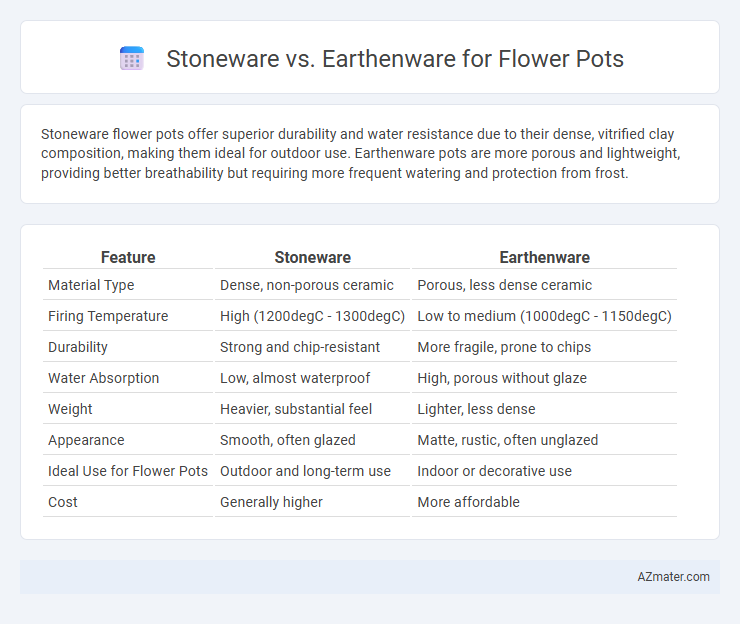Stoneware flower pots offer superior durability and water resistance due to their dense, vitrified clay composition, making them ideal for outdoor use. Earthenware pots are more porous and lightweight, providing better breathability but requiring more frequent watering and protection from frost.
Table of Comparison
| Feature | Stoneware | Earthenware |
|---|---|---|
| Material Type | Dense, non-porous ceramic | Porous, less dense ceramic |
| Firing Temperature | High (1200degC - 1300degC) | Low to medium (1000degC - 1150degC) |
| Durability | Strong and chip-resistant | More fragile, prone to chips |
| Water Absorption | Low, almost waterproof | High, porous without glaze |
| Weight | Heavier, substantial feel | Lighter, less dense |
| Appearance | Smooth, often glazed | Matte, rustic, often unglazed |
| Ideal Use for Flower Pots | Outdoor and long-term use | Indoor or decorative use |
| Cost | Generally higher | More affordable |
Introduction to Stoneware and Earthenware
Stoneware and earthenware are two popular types of ceramics used for flower pots, each with distinct properties. Stoneware is fired at high temperatures, resulting in a dense, durable, and vitrified material that is highly resistant to water and weather damage. Earthenware, fired at lower temperatures, is more porous and less durable but often favored for its rustic appearance and affordability in garden decor.
Composition and Material Differences
Stoneware flower pots are made from dense, non-porous clay fired at high temperatures (1200degC to 1300degC), resulting in a durable, waterproof material resistant to cracking and frost. Earthenware pots consist of porous clay fired at lower temperatures (1000degC to 1150degC), which makes them more breathable but less durable and prone to water absorption and breakage. The mineral composition of stoneware includes more silica and feldspar, enhancing strength and vitrification, while earthenware's higher iron oxide content gives it a distinctive reddish hue but lower vitrification.
Durability and Strength Comparison
Stoneware flower pots exhibit superior durability and strength compared to earthenware due to their dense, non-porous composition and high firing temperature, typically around 1200degC to 1300degC. Earthenware pots are more porous and fired at lower temperatures (about 1000degC to 1150degC), making them more prone to cracking and absorbing moisture, which reduces their lifespan. For outdoor gardening or heavy plant use, stoneware provides enhanced resistance to weathering and mechanical stress, making it the preferred choice for long-lasting flower pots.
Porosity and Water Retention
Stoneware flower pots feature low porosity, enabling superior water retention and reducing the need for frequent watering, making them ideal for moisture-sensitive plants. Earthenware pots, with higher porosity, allow better air circulation and drainage but require more regular watering due to faster water evaporation. Choosing between stoneware and earthenware depends on plant hydration needs and watering frequency preferences.
Aesthetic Appeal and Design Options
Stoneware flower pots offer a refined, matte finish with natural earthy tones that complement modern and rustic garden aesthetics, providing durability and a high-end appearance. Earthenware pots feature vibrant glazes and intricate hand-painted designs, allowing for more colorful and artistic expressions but tend to be more porous and fragile. Choosing between stoneware and earthenware depends on whether you prioritize understated elegance and robustness or bold, decorative versatility in your flower pot design.
Suitability for Indoor vs Outdoor Use
Stoneware flower pots offer superior durability and weather resistance, making them ideal for outdoor use where exposure to moisture and temperature fluctuations occurs. Earthenware pots, with their porous nature, enable better breathability for plant roots, suiting indoor environments where controlled conditions minimize frost and rain exposure. Choosing stoneware ensures longevity outdoors, while earthenware supports healthier indoor plants through enhanced aeration.
Weight and Handling Considerations
Stoneware flower pots are denser and heavier, providing greater stability for larger plants but may require careful handling to avoid strain or injury. Earthenware pots are lighter and easier to move, making them ideal for frequent repositioning or indoor use, though they are more fragile and prone to chipping. Choosing between stoneware and earthenware depends on balancing weight capacity with ease of handling for your specific gardening needs.
Cost and Affordability Comparison
Stoneware flower pots generally have higher production costs due to their dense, non-porous composition and firing at higher temperatures, making them more expensive than earthenware pots. Earthenware pots are more affordable, crafted from porous clay fired at lower temperatures, which reduces manufacturing expenses and retail prices. For budget-conscious buyers, earthenware offers a cost-effective option, while stoneware provides durability that justifies its premium price point.
Environmental Impact and Sustainability
Stoneware flower pots are more sustainable due to their durability and resistance to cracking, which reduces the need for frequent replacements and waste. Earthenware pots, while biodegradable, tend to be more porous and fragile, leading to shorter lifespans and increased environmental impact from production and disposal. The manufacturing process of stoneware typically involves higher firing temperatures, resulting in lower porosity and enhanced longevity, making it a more eco-friendly option for long-term gardening.
Which Pot Type is Best for Your Plants?
Stoneware flower pots offer superior durability and moisture retention, making them ideal for plants requiring consistent hydration and protection from temperature fluctuations. Earthenware pots, being more porous, promote better airflow to the roots but may dry out faster, suiting drought-tolerant and Mediterranean plants. Choosing between stoneware and earthenware depends on your plant's water needs and the environmental conditions of your growing space.

Infographic: Stoneware vs Earthenware for Flower Pot
 azmater.com
azmater.com